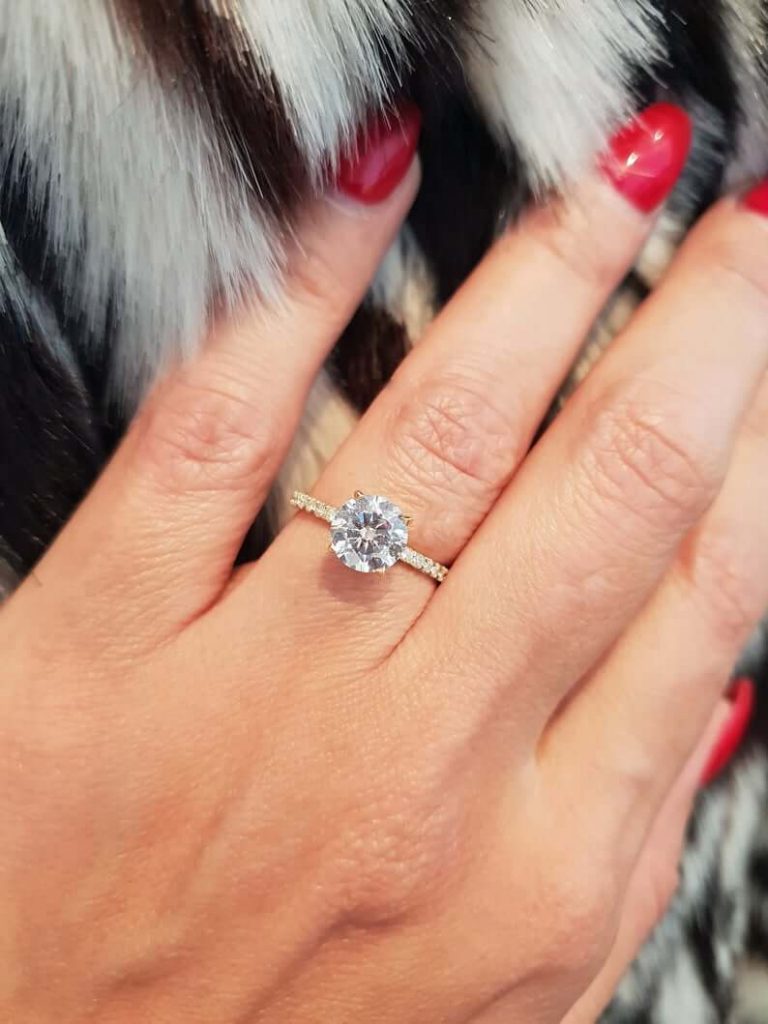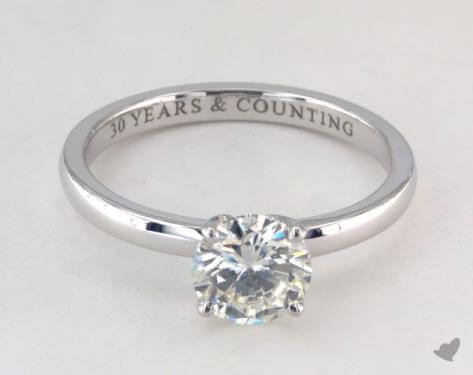As Wedding Know How editors, we write about things that we love and we think you'll like too. We have affiliate partnerships and sponsorship and may generate some revenue from these at no cost to you.
Contents
- What are SI
Diamonds? - SI1 and SI2
Diamonds – What’s Are They? - SI1 vs. SI2
Diamonds – What’s the Difference? - SI1 and SI2 Diamond – Difference in Value
- What to Avoid with SI1 and SI2 Diamonds
SI1 and SI2 clarity grades
come from the same category of diamonds, with very slight differences between
the two. These diamonds aren’t perfect, but they can offer excellent value for
someone on a budget looking for the best trade-off between value and beauty.
Here’s what you need to know
about the difference between SI1 and SI2 diamond clarity grades.
What are SI
Diamonds?
The clarity grading scale devised by the Gemological
Institute of America (GIA) is commonly used in the diamond industry to evaluate
a diamond’s clarity. There are 6 main grades, with most of them further
subdivided into smaller categories.

The highest grades are Flawless and Internally Flawless, which refer to diamonds with the very best clarity and transparency. These stones have no noticeable flaws, although miniscule ones may be visible under magnification.
The two grades Very Very Slightly Included
(VVS) and Very Slightly Included (VS) are further divided into two
grades – VVS1, VVS2, VS1 and VS2. These are for diamonds that have minor
inclusions visible under magnification. Most shoppers opt for diamonds in these
categories.
Then comes SI1 and SI2 (Slightly Included) diamonds. These stones are on the lower end of the clarity scale. They’re only followed by the Included grade, which many retailers don’t offer due to the high number of visible inclusions in them.
SI1 and SI2
Diamonds – What’s Are They?
If SI diamonds come at the lower end of the diamond
clarity scale, why are there two grades in this category and how do they
compare against each other?
Both SI1 and SI2 diamonds have inclusion within them,
however the main difference is in the number of visible inclusions.
- SI1 diamonds
have inclusions that can easily be seen under 10x magnification. In some cases,
these diamonds may be visible when the stone is viewed with the naked eye.
However, in general, finding an eye clean SI1 diamond is possible. - SI2 diamonds
are a step lower than SI1 diamonds, with inclusions that can easily be seen
under 10x magnification. Sometimes, some of these inclusions can be seen with
the naked eye too.
SI1 clarity and SI2 clarity diamonds – Check Price Difference.
The two diamonds above are very similar in
their specifications, except in their clarity grades. You can see how the SI2
diamond has many more visible inclusions that affect its beauty. This
correlates to their prices as well, as the SI1 diamond is significantly more
expensive than the SI2 stone.
SI1 vs. SI2
Diamonds – What’s the Difference?
So, the main difference between SI1 and SI2
diamonds? It all comes down to how visible the inclusions are and how
noticeable. Typically, the inclusions in an SI2 diamond are more prominent,
larger and more numerous.
But not everyone looks at a diamond via a
jeweler’s loupe, so does it matter that there are inclusions easily visible
under magnification? After all, when you show your ring to your friends and
family, it’s doubtful if anyone would whip out a magnifier to investigate your
stone.
This brings us to the most important point
about diamond clarity:
If you can’t see it, it probably
doesn’t matter.
An eye-clean diamond, regardless of which clarity
grade it comes from, is a clear diamond and should be fine for most intents and
purposes.
Check out these two rings recently
purchased by real customers on the James Allen website. Can you tell which of
these are SI1 and which is SI2? You can click on the images to see the rings in
360-degree video.
Ring with SI1 diamond and ring with SI2 diamond. Check Price difference.
The ring on the left has an SI2 diamond
while the ring on the right is SI1. However, you wouldn’t be able to tell this
simply by looking.
The point?
You can find a stunning eye-clean diamond
in these lower clarity grades, which will allow you to save on your diamond
significantly. However, eye-clean diamonds are much harder to come by in the
SI2 category, due to the larger, darker inclusions that they tend to have. This
is why you will likely find better diamonds in the SI1 grade.
SI1 and SI2 Diamond – Difference in Value
If all else is equal, a diamond with a better clarity
grade will be more expensive than a diamond with a lower grade. Each step up in
the clarity scale comes with a noticeable increase in price.
To illustrate that, compare these two diamonds on
either end of the clarity scale and note their prices:
- 1.05 Internally Flawless (IF), G Color Excellent Cut Diamond
- 1.05 Slightly Included 2 (SI2) G Color Excellent Cut Diamond
The IF diamond is almost $10,000, while the SI2
diamond is below $4000. By picking your diamond from the SI1 and 2 grades,
you’ll be able to shave off several thousand dollars from the price of your
diamond.
But what’s the price difference between SI1 and SI2
diamonds?
- A 1 carat SI1 diamond starts at
around $4000 and can reach upwards of $8000 depending on the quality of the
stone. - A 1 carat SI2 diamond starts at
around $2500 but can reach around $7000 if the other quality factors are
high.
In general, SI grades offer the best value when it
comes to balancing price with beauty. And sometimes, you can find a pretty good
bargain in these grades, like this SI1 diamond ring owner:
My diamond is a 2.45 carat round diamond which has an SI1 grading, which typically should show some inclusions. But my stone is completely eye clean and there are no inclusions at all. Even when I hold it up close in different types of lighting, I can’t see any flaws. The diamond appraiser who appraised my stone said that it looked more like a VS2 grade diamond. It’s probable the diamond was on the border between VS2 and SI1, but because the GIA is so strict about their grading standards, they opted to go with the lower grade. This was a bargain for us and we got really lucky with our diamond. I definitely recommend looking for your diamond in the SI ranges!
What to Avoid with SI1 and SI2 Diamonds
We’ve said it once, but we’ll say it again. The most
important thing when considering diamond clarity is to opt for an eye clean
stone. Avoid stones that have dark inclusions in locations that are visible.
Some jewelry settings will hide inclusions located on
the periphery or underside of the diamond, so consider this as well when
choosing your stone.
This is why it’s very important to see imagery of the
actual diamond and not of some stock photo when purchasing a diamond, simply
because every diamond is unique.
While the grading report will outline the type of
inclusions and where these are located, seeing the diamond with your own eyes
will help you to pick the best of the bunch.
Always purchase from a retailer that offers HD videos
and photos of their diamonds as well as magnification.
SI1/SI2 Diamonds and Engagement Ring Settings

1.5 carat SI1 diamond ring by Ilani Diamonds. See it here.
For a solitaire diamond ring, for example, clarity is
very important because the diamond is the focal point. If there are many
inclusions, it can affect the light performance and brilliance of the diamond,
and what’s more, people tend to look closely at diamond rings.
In these cases, either opt for a higher clarity grade
diamond if you can afford it or take the time to search for the perfect stone
that gives you the best value in a lower clarity grade.

SI2 three stone emerald and diamond ring. See it here.
You may be able to hide any inclusions by carefully
choosing a setting. For example, a visible inclusion towards the girdle of the
diamond could be hidden by choosing a halo or bezel ring setting.
Pave can add sparkle and brilliance to the overall
ring setting, which can distract from any small inclusions in the diamond. In
general, your jeweler should be able to tell you which setting will complement
your stone the best.
For other types of diamond jewelry like solitaire
pendants, tennis bracelets
or diamond studs,
clarity becomes less important. In these cases, you could easily drop down to
even the Included grades and still have a stunning piece of jewelry.
Looking to browse SI1 and SI2 diamonds? Click here to start your search.

You may also like

How to Plan a Weekend Wedding for an Intimate Group

How to Have a Cheap (Yet Classy) Wedding

What Is a Wedding Website and Do You Need One?




